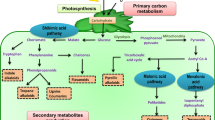Abstract
Recombinant tomato terpene synthases, TPS5/37/39, catalyze the formation of linalool or nerolidol in vitro. However, little is known about their actual biological activities in tomato plants, especially in their fruits. Here, when all three TPSs were induced in tomato fruits by a chemical elicitor, geraniol, a significant linalool peak was detected in fruit tissues but not in control fruits. Considering the compartments of these TPS proteins and available substrates, the linalool peak induced by geraniol might be attributed to TPS5 and TPS37, both of them putatively localized in the plastids where high levels of monoterpene substrate geranyl diphosphate exist. In addition, application of geraniol also triggered jasmonic acid (JA)-related defense genes suggesting that the inducible TPSs might be correlated with JA-signaled defense responses.






Similar content being viewed by others
References
Ament K, Kant MR, Sabelis MW, Haring MA, Schuurink RC (2004) Jasmonic acid is a key regulator of spider mite-induced volatile terpenoid and methyl salicylate emission in tomato. Plant Physiol 135:2025–2037
Arimura G, Garms S, MaVei M, Bossi S, Schulze B, Leitner M, Mithöfer A, Boland W (2008) Herbivore-induced terpenoid emission in Medicago truncatula: concerted action of jasmonate, ethylene and calcium signaling. Planta 227:453–464
Barbagallo RP, Oxborough K, Pallet KE, Baker NR (2003) Rapid, noninvasive screening for perturbations of metabolism and plant growth using chlorophyll fluorescence imaging. Plant Physiol 132:485–493
Chen F, Tholl D, Bohlmann J, Pichersky E (2011) The family of terpene synthases in plants: a mid-size family of genes for specialized metabolism that is highly diversified throughout the kingdom. Plant J 66:212–229
Crowell AL, Williams DC, Davis EM, Wildung MR, Croteau R (2002) Molecular cloning and characterization of a new linalool synthase. Arch Biochem Biophys 405:112–121
Davidovich-Rikanati R, Sitrit Y, Tadmor Y, Iijima Y, Bilenko N, Bar E, Carmona B, Fallik E, Dudai N, Simon JE, Pichersky E, Lewinsohn E (2007) Enrichment of tomato flavor by diversion of the early plastidial terpenoid pathway. Nat Biotechnol 25:899–901
de Carvalho CCR, da Fonseca M (2006) Biotransformation of terpenes. Biotechnol Adv 24:134–142
Demyttenaere JC, del Herrera-Carmen M, De Kimpe N (2000) Biotransformation of geraniol, nerol and citral by sporulated surface cultures of Aspergillus niger and Penicillium sp. Phytochemistry 55:363–373
Dudareva N, Pichersky E, Gershenzon J (2004) Biochemistry of plant volatiles. Plant Physiol 135:1893–1902
Falara V, Akhtar TA, Nguyen TTH, Spyropoulou EA, Bleeker PM, Schauvinhold I, Matsuba Y, Bonini ME, Schilmiller AL, Last RL, Schuurink RC, Pichersky E (2011) The tomato terpene synthase gene family. Plant Physiol 157:770–789
Goff SA, Klee HJ (2006) Plant volatile compounds: sensory cues for health and nutritional value. Science 311:815–819
Huang M, Abel C, Sohrabi R, Petri J, Haupt I, Cosimano J, Gershenzon J, Tholl D (2010) Arabidopsis ecotypes depends on allelic differences and subcellular targeting of two terpene synthases, TPS02 and TPS03. Plant Physiol 153:1293–1310
Izumi S, Takashima O, Hirata T (1999) Geraniol is a potent inducer of apoptosis-like cell death in the cultured shoot primordia of Matricaria chamomilla. Biochem Biophys Res Commun 259:519–522
Kant MR, Ament K, Sabelis MW, Haring MA, Schuurink RC (2004) Differential timing of spider mite-induced direct and indirect defenses in tomato plants. Plant Physiol 135:483–495
Keasling JD (2010) Manufacturing molecules through metabolic engineering. Science 330:1355–1388
Landmann C, Fink B, Festner M, Dregus M, Engel KH, Schwab W (2007) Cloning and functional characterization of three terpene synthases from lavender (Lavandula angustifolia). Arch Biochem Biophys 465:417–429
Li CY, Liu GH, Xu CC, Lee GI, Bauer P, Ling HQ, Ganal MW, Howea GA (2003) The tomato suppressor of prosystemin-mediated responses 2 gene encodes a fatty acid desaturase required for the biosynthesis of jasmonic acid and the production of a systemic wound signal for defense gene expression. Plant Cell 15:1646–1661
Lindmark-Henriksson M, Isaksson D, Vanek T, Högberg-ValterováI HE, Sjödin K (2004) Transformation of terpenes using a Picea abies suspension culture. J Biotechnol 107:173–184
Martin DM, Aubourg S, Schouwey MB, Daviet L, Schalk M, Toub O, Lund ST, Bohlmann J (2010) Functional annotation, genome organization and phylogeny of the grape vine (Vitis vinifera) terpene synthase gene family based on genome assembly, FLcDNA cloning, and enzyme assays. BMC Plant Biol 10:226
Nagegowda DA, Gutensohn M, Wilkerson CG, Dudareva N (2008) Two nearly identical terpene synthases catalyze the formation of nerolidol and linalool in snapdragon flowers. Plant J 55:224–239
Nieuwenhuizen NJ, Green SA, Chen X, Bailleul EJD, Matich AJ, Wang MY, Atkinson RG (2013) Functional genomics reveals that a compact terpene synthase gene family can account for terpene volatile production in apple. Plant Physiol 161:787–804
van Schie CCN, Haring MA, Schuurink RC (2007) Tomato linalool synthase is induced in trichomes by jasmonic acid. Plant Mol Biol 64:251–263
Acknowledgments
This work was supported by the Education Department Fund of Sichuan Province (No. 13ZD1110) and the Internal Fund of Southwest University of Science and Technology (No. 20145030).
Author information
Authors and Affiliations
Corresponding author
Electronic supplementary material
Below is the link to the electronic supplementary material.
Rights and permissions
About this article
Cite this article
Cao, Y., Hu, S., Dai, Q. et al. Tomato terpene synthases TPS5 and TPS39 account for a monoterpene linalool production in tomato fruits. Biotechnol Lett 36, 1717–1725 (2014). https://doi.org/10.1007/s10529-014-1533-2
Received:
Accepted:
Published:
Issue Date:
DOI: https://doi.org/10.1007/s10529-014-1533-2




